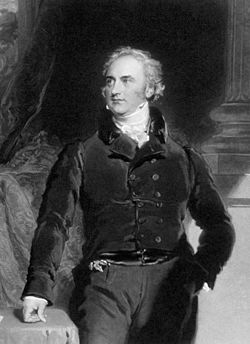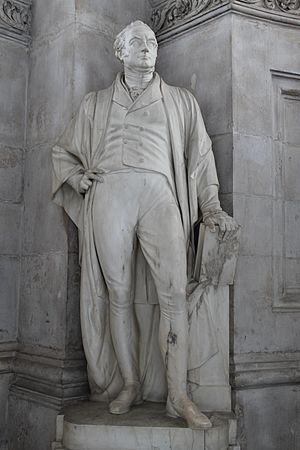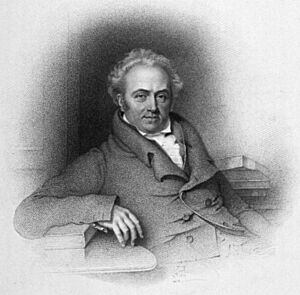Astley Cooper facts for kids
Quick facts for kids
Astley Cooper
|
|
|---|---|

Astley Cooper by Thomas Lawrence
|
|
| Born | 23 August 1768 Brooke, Norfolk, England
|
| Died | February 12, 1841 (aged 72) London, England
|
| Nationality | British |
| Known for | otology vascular surgery human anatomy |
| Awards | Copley Medal (1801) |
| Scientific career | |
| Fields | anatomy |
Sir Astley Paston Cooper (born August 23, 1768 – died February 12, 1841) was a famous British surgeon and expert in human anatomy. He made many important discoveries in medicine. He helped us understand the ear, blood vessels, and how the body is built. He also improved surgery for conditions like hernias.
Contents
Life of a Famous Surgeon
Astley Cooper was born in a place called Brooke Hall in Norfolk, England. This was on August 23, 1768. His father was a clergyman, and his mother wrote novels.
When he was 16, Astley moved to London. He started training with Henry Cline, a surgeon at St Thomas' Hospital. Astley loved studying anatomy, which is the study of the body's structure. He even got to attend lectures by John Hunter, another very famous surgeon.
Early Career and Awards
In 1789, Astley became an anatomy teacher at St Thomas' Hospital. By 1791, he was teaching both anatomy and surgery there. In 1800, he became a surgeon at Guy's Hospital. This happened after his uncle, William Cooper, passed away.
In 1802, Astley Cooper won a special award called the Copley Medal. He earned it for his research on the eardrum. He also became a member of the Royal Society, a group for top scientists.
In 1804, he published the first part of his important book about hernias. This book made him very well-known. By 1813, he was earning a lot of money from his medical work. In the same year, he became a professor at the Royal College of Surgeons. He was a very popular teacher.
Royal Connections and Later Life
In 1817, Astley Cooper performed a very difficult surgery. He tied off a major blood vessel in the belly to help a patient. In 1820, he removed a lump from the head of King George IV.
About six months later, the King made him a "Baronet." This is a special title, like a knight. Since Astley had no sons, the title would go to his nephew. In 1828, he became the King's personal surgeon.
Astley Cooper was also the president of the Royal College of Surgeons twice. He was also a vice-president of the Royal Society. He passed away on February 12, 1841, in London. He is buried in a special crypt at Guy's Hospital. A statue of him stands in St Paul's Cathedral.
Local Legacy
Astley Cooper lived in a town called Hemel Hempstead. He helped make sure the main railway line was built away from the town. This meant the town did not get its own train station.
Today, Astley Cooper is still remembered. There are streets named after him in his hometown and in Hemel Hempstead. A school in Hemel Hempstead is also named The Astley Cooper School.
Amazing Medical Discoveries

Astley Cooper was a pioneer in many areas of medicine. He was especially good at understanding blood vessels and how blood flows in the brain.
Vascular Surgery
He was the first to show what happens if you tie off the main neck arteries in dogs. He also suggested tying off blood vessels to treat aneurysms. An aneurysm is a bulge in a blood vessel. In 1805, he wrote about trying to tie off a neck artery for a patient. In 1817, he successfully tied off a very large artery in the belly.
Anatomical Discoveries
Astley Cooper was an expert in anatomy. He found several body parts that no one had described before. Many of these are now named after him:
- Cooper's fascia: A covering around a part of the male body.
- Cooper's stripes: Strong fibers in the arm ligaments.
- Cooper's ligaments: Special ligaments that support the breasts.
He also described new diseases, which were also named after him:
- Cooper's disease: Harmless cysts (small sacs) in the breast.
- Cooper's hernia: A type of hernia (when an organ pushes through a weak spot).
- Cooper's neuralgia: Pain in the breast area.
Published Works
Astley Cooper wrote many important books about his medical findings. Some of his main books include:
- Anatomy and Surgical Treatment of Hernia (1804–1807)
- Dislocations and Fractures (1822)
- Lectures on Surgery (1824–1827)
- Illustrations of Diseases of the Breast (1829)
- Anatomy of the Thymus Gland (1832)
- Anatomy of the Breast (1840)
Many of the actual body parts and surgical tools he used are now kept in the Gordon Museum of Pathology.
See also
- Pathology
- List of pathologists


